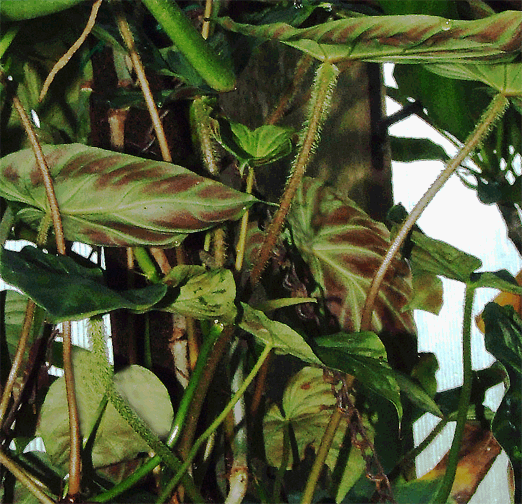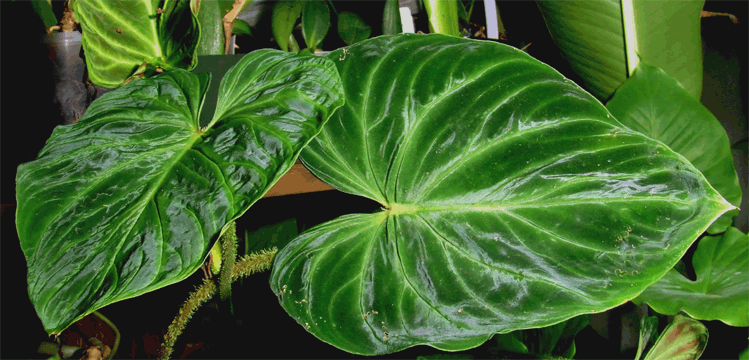![]()
Aroids and other genera in the Collection
Take the Tour Now?
Orchids
The
Exotic Rainforest
Plants in
the Exotic Rainforest Collection
Images on this website are copyright protected. Contact
us before any reuse.
In depth information on how to grow Philodendron species, Click this Link
Within our collection we have many species of Philodendron. If you are seeking other photos, click this link
Philodendron verrucosum L. Mathieu ex Schott

Stories persist that Philodendron verrucosum is capable of growing leaves measuring 90cm (3 feet) tall that are velutinous and feel and look like velvet. The scientific term velutinous indicates the leaf blade has its surface covered with a fine and dense silky pubescence (hair) thus making the blade appear velvety. Scientific studies completed in the field indicate the average blade size is 28 to 75cm long (just under one foot to 2.5 feet) by 19 to 60cm (.6 feet to 2 feet) wide. As a result the 210cm size appears to be at least a bit exaggerated but Philodendron species are not limited in size if growing under ideal conditions. Philodendron verrucosum is primarily found from Costa Rica, Panama, Colombia down through Ecuador and Peru. The species has been collected at elevations ranging from 50 to 2000 meters (165 to 6550 feet) above sea level.
 The beautiful
Philodendron grows in
pre-mountainous rain forest
regions mostly above 500 meters (1600 feet) in
elevation. Originally identified in 1854, Philodendron
verrucosum is one of the most sought
after Philodendron sp. known to serious collectors and often demands a
steep price. The rare plant has become
slightly more common due to the interest it stirs in "plant nuts"
and their willingness to pay for a specimen.
The beautiful
Philodendron grows in
pre-mountainous rain forest
regions mostly above 500 meters (1600 feet) in
elevation. Originally identified in 1854, Philodendron
verrucosum is one of the most sought
after Philodendron sp. known to serious collectors and often demands a
steep price. The rare plant has become
slightly more common due to the interest it stirs in "plant nuts"
and their willingness to pay for a specimen.
According to the published work of aroid botanist Dr. Thomas B. Croat Ph.D., P.A. Schulze Curator of Botany of the Missouri Botanical Garden in St. Louis, MO. is normally hemiepiphytic. That classification of plants can best be understood as almost an epiphyte (ep-a-FIT) growing attached to a host tree without drawing nourishment from the host. hemiepiphyte (hem-a-EPA-fit)s may begin life as a seed dropped on the branch of a tree by a bird in its droppings which finally sends roots down to the soil or is rooted in soil and then climbs any nearby tree.
According to Dr. Croat's journal A Revision of Philodendron Subgenus Philodendron (ARACEAE) for Mexico and Central America Volume 84, Number 3, 1997 Philodendron verrucosum is rarely completely epiphytic or terrestrial. Yet collectors tend to grow it as a potted plant without allowing it to climb which would appear to prevent a specimen from growing as large as possible or reaching its full potential beauty.
The petioles
which support the leaf blades are terete (round) and purplish in color
as well as covered with pubescence (hair) growing from
top to bottom on at least one side. Despite the common
misconception, the petiole is not the "stem" which is a term frequently
but incorrectly used by collectors. The petiole is the stalk which
connects the leaf blade to the
 stem which is at the base of the plant.
As a result the stem is not the support for any single leaf as is often
claimed by collectors but instead is the portion of the plant collectors
often refer to as the "cane". The petioles emerge from nodes along
the stem which are divided by internodes which are the stem segments
between two nodes.
stem which is at the base of the plant.
As a result the stem is not the support for any single leaf as is often
claimed by collectors but instead is the portion of the plant collectors
often refer to as the "cane". The petioles emerge from nodes along
the stem which are divided by internodes which are the stem segments
between two nodes.
The leaf blades feel and look as if they were cut from a roll of mottled deep green velvet with delicate markings of lighter greens and touches ranging towards silver. The underside of the leaf blade is stained purple red (see leaf in main photo about to unfurl as well as inset). The new leaf blades emerge from a cataphyll which is green and deciduous which means the cataphylls fall from the plant. The cataphylls which surround any newly emerging leaf blade are sharply single ribbed and a medium green in color. A cataphyll is a bract-like modified leaf that surrounds and protects the newly emerging blade. The cataphyll is the singular most important identifying characteristic of an aroid. The leaf blades are thin (subcoriaceous) while both dark and velvety on the adaxial (upper) surface but are paler in color along the major veins. The leaf blade is tinged purplish on the underside.
 All Philodendron sp.
are aroids. An aroid is a plant that reproduces via the production of
an inflorescence known to science as a spathe and spadix. Most people
think the spathe is a "flower", it is not. The spathe is simply a modified leaf
appearing to be
a hood. If you explore the inflorescence, with a magnifying
glass when it is ready to be pollinated there are very tiny flowers and
that can be found on the spadix at the center of the inflorescence.
The spadix The
inflorescence, which is sometimes shaped like a tube, is made of several
parts. The portion that appears to be the "flower" is the spathe and
inside that is the spadix which somewhat resembles an elongated pine
cone.
The spadix is a spike
on a thickened fleshy axis which can produce tiny flowers.
When ready to reproduce, the spadix produces both male, female
and sterile flowers. These are separated by the sterile zone of
strerile male flowers.
The tiny male flowers produce pollen and the tiny female flowers are
designed to be receptive to pollen. However, most are cleverly divided
by nature to keep the plant from being self pollinated. Nature's
preferred method is to have insects (beetles) pick up the pollen from
one plant and carry it to a second plant to keep the species strong.
All Philodendron sp.
are aroids. An aroid is a plant that reproduces via the production of
an inflorescence known to science as a spathe and spadix. Most people
think the spathe is a "flower", it is not. The spathe is simply a modified leaf
appearing to be
a hood. If you explore the inflorescence, with a magnifying
glass when it is ready to be pollinated there are very tiny flowers and
that can be found on the spadix at the center of the inflorescence.
The spadix The
inflorescence, which is sometimes shaped like a tube, is made of several
parts. The portion that appears to be the "flower" is the spathe and
inside that is the spadix which somewhat resembles an elongated pine
cone.
The spadix is a spike
on a thickened fleshy axis which can produce tiny flowers.
When ready to reproduce, the spadix produces both male, female
and sterile flowers. These are separated by the sterile zone of
strerile male flowers.
The tiny male flowers produce pollen and the tiny female flowers are
designed to be receptive to pollen. However, most are cleverly divided
by nature to keep the plant from being self pollinated. Nature's
preferred method is to have insects (beetles) pick up the pollen from
one plant and carry it to a second plant to keep the species strong.
Philodendron verrucosum produces an inflorescence from April through June in South America but in September and October in Central America. The species produces one inflorescence per axil while the peduncle which supports the spathe is a dark green. A peduncle supports the inflorescene and is the stalk-like structure between the spathe and the last foliage leaf. The spathe is green to dark green and matte as well as scaly on the outside.
The spathe is red inside the tube and tinged brownish on the spathe blade. Female flowers can be found inside the female floral chamber near the base of the spathe, but the are only receptive on the first night the spathe is open. There is a cluster of sterile male flowers found between the female flowers (still hidden inside the floral chamber) and the male flowers which are fertile and produce pollen only on the second day and then the spathe closes. Information on how Philodendron species are pollinated in nature can be found here: Aroid pollination
The plant prefers light shade and cool climates due to it's native habitat, much of which is in the Andes Mountains of South America. Although the plant is often grown potted by collectors it does not show its beauty by running across the ground. The true beauty and blade size will only be seen if you allow it to climb. I once read a report from a grower which said they "hated" to cut the plant. I have found if you don't cut it Philodendron verrucosum can become very "leggy" and quite unattractive. As a result, I cut it and repot it relatively often since the petioles become stringy in appearance.
Philodendron verrucosum roots
relatively quickly and begins new plants that spread and climb. However, the
plant can be touchy and sometimes refuses to root for quite a long
period. Interestingly, this species appears to grow faster in the
 winter months when the temps are consistently in the 15.5 to 21 degree C
(60 to 70 F)
range.
winter months when the temps are consistently in the 15.5 to 21 degree C
(60 to 70 F)
range.
The average blades on our four specimens are approximately 22cm (9 inches). The main plant now stands over 90cm (3 feet) tall. We grow our specimens in a mixture of good potting soil, peat, Perlite™ and orchid potting media with a tall totem. This mixture is very fast draining but allows the roots to quickly absorb ample water. During the summer the plants are watered almost daily and during winter every other day. Photos of the adult leaf in nature are substantially different than those of the smaller plants normally seen in private collections.
Philodendron species are known to be highly variable and not every leaf of every specimen will always appear the same. Specimens of Philodendron verrucosum collected in Ecuador often appear very different from those collected in Central America. This link explains in greater detail the scientific principle of natural variation and morphogenesis. Click here.
Looking for a specimen? Contact
http:///
![]()
If you are seeking information on other
rare species, click on "Aroids and other genera in the Collection" at the top and look
for the
Want to learn more
about aroids?
Join the
International Aroid Society:
http://www.exoticrainforest.com/Join%20IAS.html